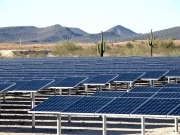
The Lake Pleasant Water Treatment Plant in Phoenix, Arizona, has installed a new 7.5MW solar power system consisting of a total of 22,936 solar panels and expected to generate most of the plant’s electricity thereby saving approximately $4.2 million in energy costs over the next 20 years in comparison to conventional power. The solar power system will also save more than 9,000 tons of carbon dioxide per year, roughly equivalent to the removal of 35,800 cars from Arizona’s roads.
The solar system was designed and built by SunPower Corporation and is the largest such installation built on city-owned property.
“With more than 300 days of sunshine each year, Phoenix is a natural for using solar power,” said Phoenix Mayor Greg Stanton . “The Lake Pleasant Water Treatment Plant project is the latest in a series of solar initiatives utilized at various city locations to increase the city's commitment to sustainable energy development.”
Councilman Bill Gates, the chairman of the city Finance, Efficiency, Innovation and Sustainability Subcommittee, described the installation as a great example of progressive thinking intended to keep customers costs as low as possible.
SunPower solar systems have also been installed at Sky Harbor, the Phoenix Convention Center and the Burton Barr Central Library. The convention centre and library systems are 100kW systems that are Leadership in Energy and Environmental Design (LEED) Silver certified. The system at the water treatment plant features a 6MW ground mounted solar array with a SunPower tracker system that enables the solar panels to follow the sun’s movement across the sky thereby increasing the amount of solar power captured by up to 25 percent over conventional fixed-tilt systems and reducing land requirements.
The system has been financed through a solar services agreement with SunPower under which Wells Fargo owns the system with responsibility for operation and maintenance remaining with SunPower. The city will buy generated electricity at rates competitive with retail prices thereby helping to mitigate the effect of rising energy costs. Renewable Energy Credits (REC’s) will be transferred to Arizona Public Service (APS) which helped to facilitate the installation through its Renewable Energy Incentive Program. The scheme is essentially an incentives program which offers financial incentives to customers in order to offset 40 percent of installation costs for solar energy.
Further information:

